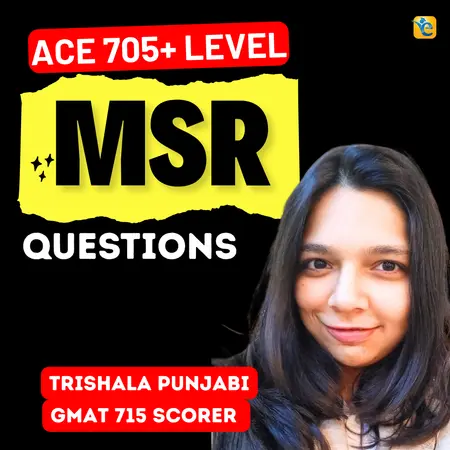Events & Promotions
|
|

GMAT Club Daily Prep
Thank you for using the timer - this advanced tool can estimate your performance and suggest more practice questions. We have subscribed you to Daily Prep Questions via email.
Customized
for You
Track
Your Progress
Practice
Pays
Not interested in getting valuable practice questions and articles delivered to your email? No problem, unsubscribe here.
- Nov 22
11:00 AM IST
-01:00 PM IST
Do RC/MSR passages scare you? e-GMAT is conducting a masterclass to help you learn – Learn effective reading strategies Tackle difficult RC & MSR with confidence Excel in timed test environment - Nov 23
11:00 AM IST
-01:00 PM IST
Attend this free GMAT Algebra Webinar and learn how to master the most challenging Inequalities and Absolute Value problems with ease. - Nov 25
10:00 AM EST
-11:00 AM EST
Prefer video-based learning? The Target Test Prep OnDemand course is a one-of-a-kind video masterclass featuring 400 hours of lecture-style teaching by Scott Woodbury-Stewart, founder of Target Test Prep and one of the most accomplished GMAT instructors.
Kudos
Bookmarks
B
Be sure to select an answer first to save it in the Error Log before revealing the correct answer (OA)!
Difficulty:
 15%
(low)
15%
(low)
Question Stats:
83% (01:54) correct 17%
(02:09)
wrong
17%
(02:09)
wrong  based on 2270
sessions
based on 2270
sessions
History
Date
Time
Result
Not Attempted Yet
At several locations on the northwest coast of North America are formations known as chevrons—wedge-shaped formations of mounded sediment—pointing toward the ocean. Most geologists take them to have been formed by erosion, but recently other scientists have proposed that they were thrown up from the ocean by massive waves triggered by meteor impacts in the Pacific Ocean.
Which of the following, if discovered, would most help in deciding which hypothesis is correct?
A) Chevron-like structures which are not currently near glaciers, large rivers, or other bodies of water
B) The presence, in chevrons, of deposits of ocean microfossils containing metals typically formed by meteor impacts
C) Oral-history evidence for flooding that could have been caused by ocean waves
D) The fact that exact data about the location and depth of any meteor impact craters on the Pacific seabed is lacking
E) The fact that certain changes in the shape and location of maritime sand dunes have been produced by the action of wind and waves
Which of the following, if discovered, would most help in deciding which hypothesis is correct?
A) Chevron-like structures which are not currently near glaciers, large rivers, or other bodies of water
B) The presence, in chevrons, of deposits of ocean microfossils containing metals typically formed by meteor impacts
C) Oral-history evidence for flooding that could have been caused by ocean waves
D) The fact that exact data about the location and depth of any meteor impact craters on the Pacific seabed is lacking
E) The fact that certain changes in the shape and location of maritime sand dunes have been produced by the action of wind and waves
ID: 500329
CR59590.02
CR59590.02
Kudos
Bookmarks
generis
Phenomenon - Wedge shaped structures on the coast.
Hypothesis 1 - Erosion formed these (perhaps the impact of the waves on rocks)
Hypothesis 2 - Thrown up from oceans by meteor impact
The presence of what will help in deciding which hypothesis is correct (strong support for one and weaken the other)
A) Chevron-like structures which are not currently near glaciers, large rivers, or other bodies of water
If we find similar structures away from water bodies, it doesn't support either hypothesis. Both hypotheses are based on impact of water or water bodies. Since such structures would have been found far from water bodies, they would support neither hypothesis.
Since hypothesis 1 doesn't specifically say 'erosion by water,' we could imagine erosion being wind erosion but then "wedge-shaped formations of mounded sediment—pointing toward the ocean" doesn't make sense. It ought to have something to do with ocean. So not convincing at all.
B) The presence, in chevrons, of deposits of ocean microfossils containing metals typically formed by meteor impacts
Chevrons have ocean microfossils (so likely they came out of the ocean) and they contain metals formed by meteor impact then it seems that meteor impact caused them to come out of the ocean. This strongly supports hypothesis 2 and also weaken hypothesis 1. If they were rocks on the coast and were formed by erosion by waves, how would they contain ocean microfossils? Hence, it helps us in deciding which hypothesis is correct.
C) Oral-history evidence for flooding that could have been caused by ocean waves
The moment we read 'oral history,' this option should be frowned upon. Oral history is narrated history by a person as per his/her impressions. This becomes more like 'opinion' than a 'fact.' So will it provide evidence? I am already doubtful.
D) The fact that exact data about the location and depth of any meteor impact craters on the Pacific seabed is lacking
A lack of data is not evidence. Perhaps it is there but has not been found yet. Perhaps there is none but it actually did happen.
E) The fact that certain changes in the shape and location of maritime sand dunes have been produced by the action of wind and waves
No comparison is given between chevrons and sand dunes. We don't know whether they are similar in any way so any data about sand dunes doesn't help us.
Answer (B)
Kudos
Bookmarks
generis
Imo B.
Hypothesis 1 - formed by erosion
Hypothesis 2 - they were thrown up from the ocean by massive waves triggered by meteor impacts in the Pacific Ocean.
Now we have find the necessary information from the answer choices that can help in deciding which hypothesis is correct.
A - Chevron-like structures does not necessarily mean that Chevron actually formed in distant places. It may also be the case that lake or river once existed and in time disappeared. Any how we can not decide so just drop it.
B- Correct If presence of deposits of ocean microfossils containing metals typically formed by meteor impacts then it certainly points out that Hypothesis 2 is correct.
C - Oral history can not the basis for scientific discover. There can be many interpretations.
D - While it does negate hypothesis 2, but that does not mean that hypothesis 1 is correct.
Negation of one hypothesis does not mean that the other hypothesis is correct. This is not a casual relationship.
E - This option suggests that Chevron formation was the result of both wind and waves. It certainly does not help our case.
I think my reasoning for dropping A is somewhat limited.
I would like some expert to validate my reasoning.











